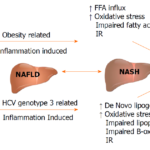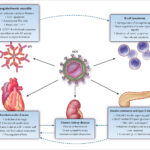Chronic hepatitis C (CHC) is a significant public health concern globally, and among the various strains of the hepatitis C virus (HCV), genotype 4 stands as one of the most prominent. This article delves into the essential aspects of chronic hepatitis C, with a specific focus on genotype 4, highlighting its impact, treatment options, and the latest medical advancements.

What is Hepatitis C and Genotype 4?
Hepatitis C is a viral infection that primarily affects the liver, leading to inflammation, scarring, and, if untreated, liver failure. The virus is classified into several genotypes, which are distinct variations of the virus based on genetic differences. Genotype 4, though less common in certain regions, is prevalent in the Middle East, sub-Saharan Africa, and parts of Europe.
Genotype 4 and Its Genetic Characteristics
HCV genotype 4 is subdivided into several subtypes, labeled 4a, 4d, and others. These subtypes differ slightly in their genetic makeup, which can influence the effectiveness of treatment regimens and disease progression. Understanding these genetic variations is crucial for tailoring appropriate therapeutic approaches for patients with genotype 4 infections.
Epidemiology and Risk Factors for Hepatitis C Genotype 4
Global Prevalence of Hepatitis C Genotype 4
HCV genotype 4 is the most prevalent genotype in regions such as the Middle East, North Africa, and parts of sub-Saharan Africa. In fact, it is estimated that nearly 40-50% of hepatitis C cases in these areas are caused by genotype 4. While genotype 1 is more common in Western countries, genotype 4 remains a significant concern for populations in regions with higher infection rates.
Key Risk Factors for Genotype 4 Infection
The transmission of HCV primarily occurs through blood-to-blood contact. Some of the key risk factors for contracting genotype 4 include:
- Sharing needles or other drug paraphernalia
- Receiving unscreened blood transfusions or organ transplants
- Occupational exposure to blood (e.g., healthcare workers)
- Tattoos or piercings done with unsterilized equipment
- Being born to a mother with hepatitis C
In addition, individuals who have had long-term exposure to unsterilized medical or dental instruments in areas with high rates of hepatitis C are at increased risk of contracting the virus.
Symptoms of Chronic Hepatitis C Genotype 4
The symptoms of chronic hepatitis C, including genotype 4, may remain mild or undetectable for many years, making the disease difficult to diagnose in its early stages. When symptoms do appear, they can include:
- Fatigue
- Jaundice (yellowing of the skin and eyes)
- Abdominal pain or discomfort (particularly in the upper right side)
- Dark urine
- Unexplained weight loss
- Joint pain
Long-term Effects of Chronic Hepatitis C
Without proper treatment, chronic hepatitis C genotype 4 can progress to more severe liver conditions, such as cirrhosis, liver failure, or hepatocellular carcinoma (liver cancer). These complications are often the result of the persistent inflammation caused by the virus, which over time damages liver tissue.
Diagnosis of Chronic Hepatitis C Genotype 4
Diagnostic Tests for Hepatitis C
Diagnosis of hepatitis C involves several key steps:
- HCV Antibody Test: This initial test screens for antibodies against the hepatitis C virus. A positive result indicates that a person has been exposed to the virus.
- Polymerase Chain Reaction (PCR) Test: This test measures the amount of HCV RNA in the blood, determining whether the infection is active.
- HCV Genotype Testing: This test identifies the specific genotype of HCV, which is essential for selecting the appropriate treatment regimen. For genotype 4, specific antiviral agents are preferred due to differences in viral behavior and drug resistance patterns.
- Liver Biopsy or Imaging: In some cases, doctors may perform a biopsy or use imaging techniques such as elastography to assess liver damage or fibrosis.
Treatment Options for Hepatitis C Genotype 4
Antiviral Therapy for Genotype 4
Treatment for chronic hepatitis C genotype 4 has evolved significantly over the past decade, thanks to the development of direct-acting antivirals (DAAs). These medications target the virus directly, inhibiting its replication and improving the chances of a sustained virologic response (SVR), meaning the virus is undetectable in the blood after treatment.
For genotype 4, a combination of DAAs is often used, including:
- Sofosbuvir (a nucleotide polymerase inhibitor)
- Ledipasvir (a nonstructural protein 5A inhibitor)
- Daclatasvir (another nonstructural protein 5A inhibitor)
- Velpatasvir (a pan-genotypic NS5A inhibitor)
The choice of combination therapy depends on factors such as previous treatment history, the degree of liver damage, and potential drug resistance patterns. The duration of treatment typically ranges from 8 to 12 weeks, and cure rates for genotype 4 can exceed 90%.
Liver Transplantation
In cases where chronic hepatitis C genotype 4 leads to severe liver damage, such as cirrhosis or liver failure, a liver transplant may be considered. However, because hepatitis C can recur after a transplant, patients may need antiviral therapy both before and after the procedure to prevent reinfection.
Advances in Hepatitis C Research and Genotype 4
Ongoing research into hepatitis C genotype 4 aims to develop even more effective treatments, improve diagnostics, and better understand the virus’s genetic diversity. Recent studies have focused on optimizing DAAs for use in challenging populations, including those with cirrhosis or HIV co-infection.
New Treatment Regimens and Clinical Trials
Clinical trials for new antiviral combinations continue to explore treatments that can provide a cure for genotype 4 with fewer side effects and shorter treatment durations. Researchers are also investigating potential vaccine candidates, though a widely available vaccine for hepatitis C has not yet been developed.
Prevention of Hepatitis C Genotype 4
Prevention strategies for hepatitis C genotype 4 are similar to those for other genotypes and focus on reducing the risk of exposure to the virus. Key prevention measures include:
- Safe blood transfusions and organ donations with rigorous screening
- Safe injection practices and harm reduction programs for people who inject drugs
- Education on safe tattoo and piercing practices
- Use of personal protective equipment for healthcare workers

